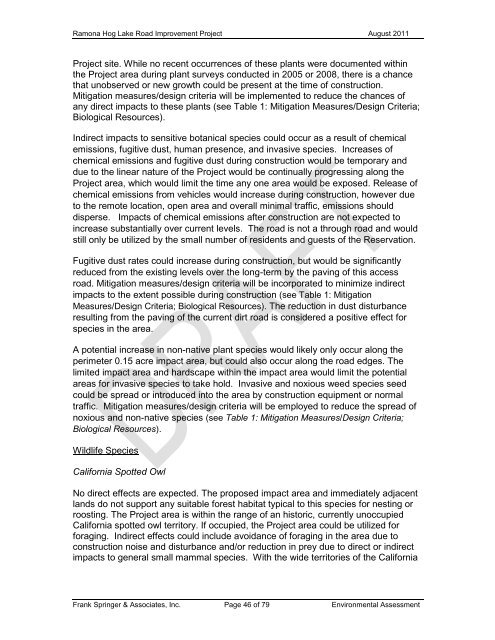environmental assessment for the hog lake road improvement project
environmental assessment for the hog lake road improvement project
environmental assessment for the hog lake road improvement project
You also want an ePaper? Increase the reach of your titles
YUMPU automatically turns print PDFs into web optimized ePapers that Google loves.
Ramona Hog Lake Road Improvement Project August 2011<br />
Project site. While no recent occurrences of <strong>the</strong>se plants were documented within<br />
<strong>the</strong> Project area during plant surveys conducted in 2005 or 2008, <strong>the</strong>re is a chance<br />
that unobserved or new growth could be present at <strong>the</strong> time of construction.<br />
Mitigation measures/design criteria will be implemented to reduce <strong>the</strong> chances of<br />
any direct impacts to <strong>the</strong>se plants (see Table 1: Mitigation Measures/Design Criteria;<br />
Biological Resources).<br />
Indirect impacts to sensitive botanical species could occur as a result of chemical<br />
emissions, fugitive dust, human presence, and invasive species. Increases of<br />
chemical emissions and fugitive dust during construction would be temporary and<br />
due to <strong>the</strong> linear nature of <strong>the</strong> Project would be continually progressing along <strong>the</strong><br />
Project area, which would limit <strong>the</strong> time any one area would be exposed. Release of<br />
chemical emissions from vehicles would increase during construction, however due<br />
to <strong>the</strong> remote location, open area and overall minimal traffic, emissions should<br />
disperse. Impacts of chemical emissions after construction are not expected to<br />
increase substantially over current levels. The <strong>road</strong> is not a through <strong>road</strong> and would<br />
still only be utilized by <strong>the</strong> small number of residents and guests of <strong>the</strong> Reservation.<br />
Fugitive dust rates could increase during construction, but would be significantly<br />
reduced from <strong>the</strong> existing levels over <strong>the</strong> long-term by <strong>the</strong> paving of this access<br />
<strong>road</strong>. Mitigation measures/design criteria will be incorporated to minimize indirect<br />
impacts to <strong>the</strong> extent possible during construction (see Table 1: Mitigation<br />
Measures/Design Criteria; Biological Resources). The reduction in dust disturbance<br />
resulting from <strong>the</strong> paving of <strong>the</strong> current dirt <strong>road</strong> is considered a positive effect <strong>for</strong><br />
species in <strong>the</strong> area.<br />
A potential increase in non-native plant species would likely only occur along <strong>the</strong><br />
perimeter 0.15 acre impact area, but could also occur along <strong>the</strong> <strong>road</strong> edges. The<br />
limited impact area and hardscape within <strong>the</strong> impact area would limit <strong>the</strong> potential<br />
areas <strong>for</strong> invasive species to take hold. Invasive and noxious weed species seed<br />
could be spread or introduced into <strong>the</strong> area by construction equipment or normal<br />
traffic. Mitigation measures/design criteria will be employed to reduce <strong>the</strong> spread of<br />
noxious and non-native species (see Table 1: Mitigation Measures/Design Criteria;<br />
Biological Resources).<br />
Wildlife Species<br />
Cali<strong>for</strong>nia Spotted Owl<br />
No direct effects are expected. The proposed impact area and immediately adjacent<br />
lands do not support any suitable <strong>for</strong>est habitat typical to this species <strong>for</strong> nesting or<br />
roosting. The Project area is within <strong>the</strong> range of an historic, currently unoccupied<br />
Cali<strong>for</strong>nia spotted owl territory. If occupied, <strong>the</strong> Project area could be utilized <strong>for</strong><br />
<strong>for</strong>aging. Indirect effects could include avoidance of <strong>for</strong>aging in <strong>the</strong> area due to<br />
construction noise and disturbance and/or reduction in prey due to direct or indirect<br />
impacts to general small mammal species. With <strong>the</strong> wide territories of <strong>the</strong> Cali<strong>for</strong>nia<br />
Frank Springer & Associates, Inc. Page 46 of 79 Environmental Assessment
















